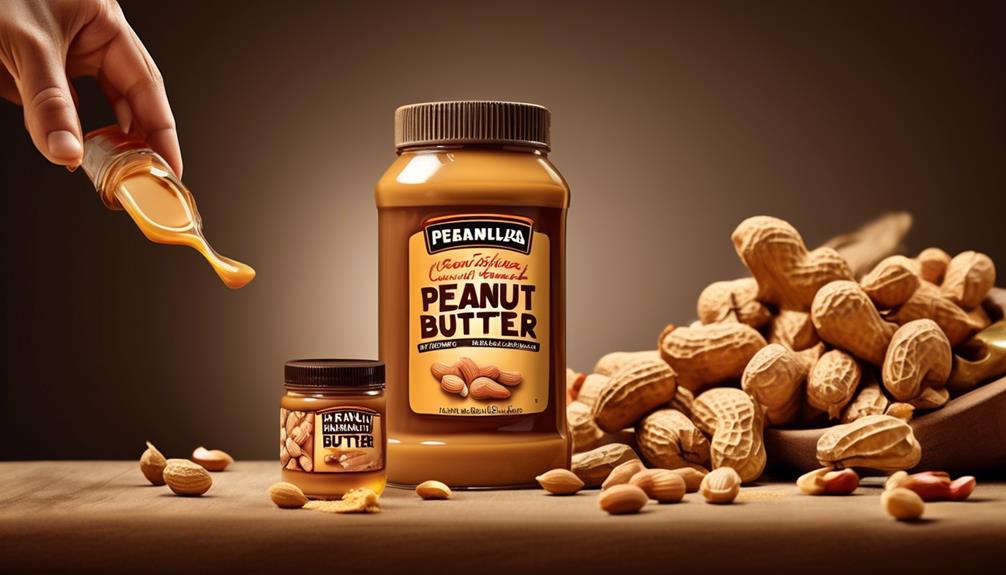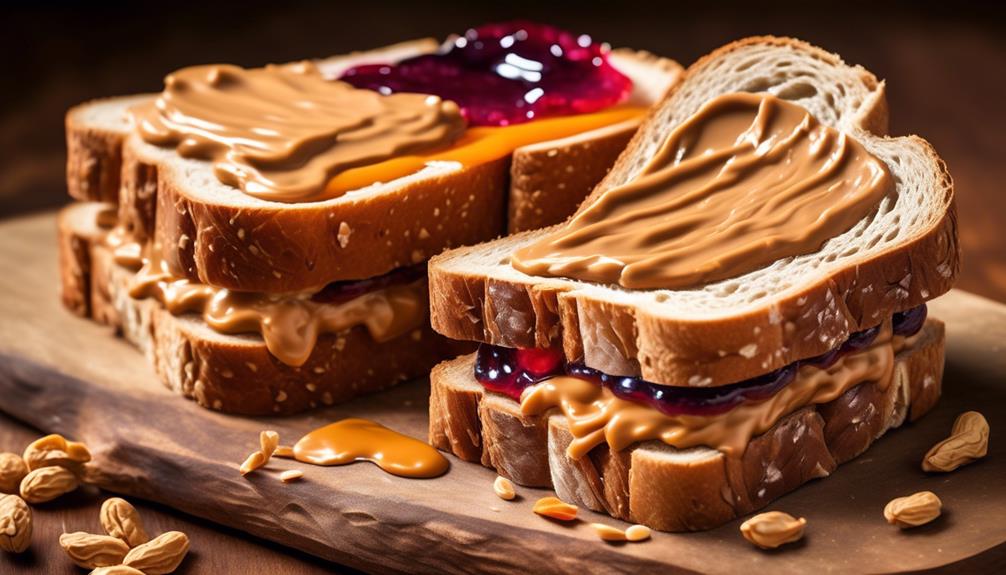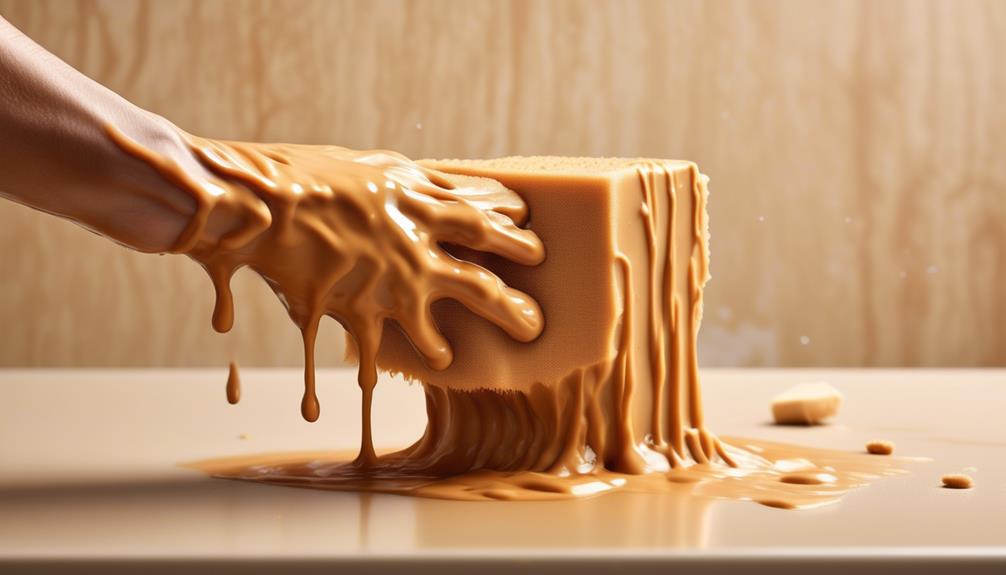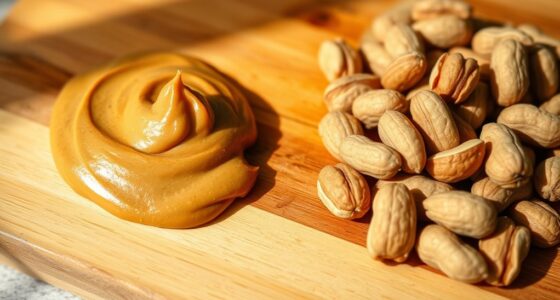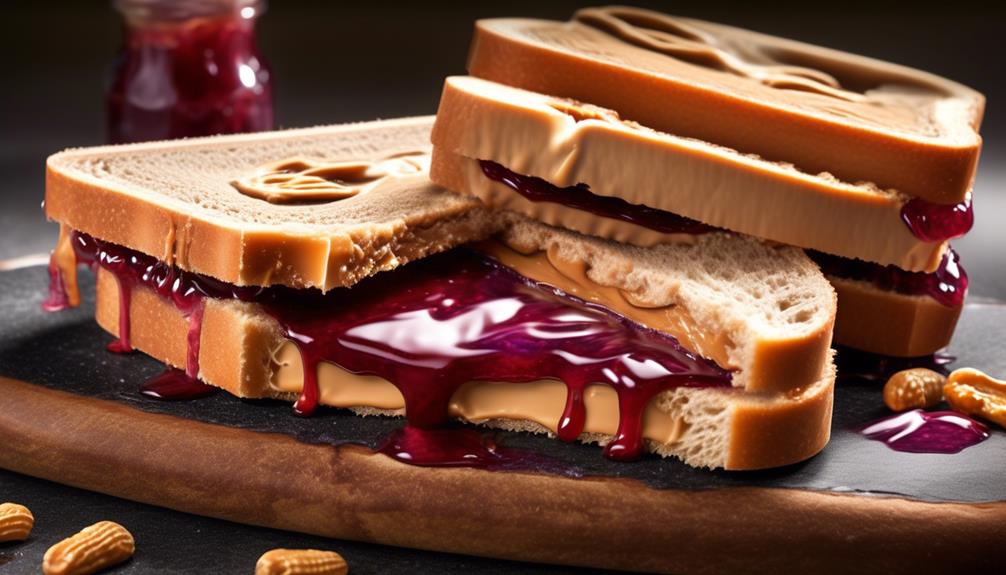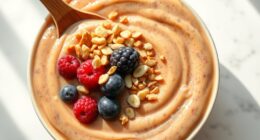Have you ever pondered why some individuals, ourselves included, have an allergy to peanut butter but not peanut oil?
It's a puzzling question, and there are several theories that attempt to explain this discrepancy.
Understanding the science behind these allergies can shed light on the factors at play and potentially provide insights into managing or even mitigating allergic reactions.
So, what exactly sets peanut butter and peanut oil apart in terms of allergenicity, and what implications does this have for individuals with peanut allergies?
Key Takeaways
- Refined peanut oil has minimal allergenic proteins and is generally safe for individuals with peanut allergies.
- Unrefined peanut oil retains peanut proteins and should be avoided by those with peanut allergies.
- Cross-contamination in food preparation and cooking processes can pose a risk for individuals with allergies.
- Inquiring about the type of oil used in food preparation and reading ingredient labels is essential to avoid hidden peanut ingredients.
Understanding Peanut Allergies
Understanding Peanut Allergies is crucial for individuals and caregivers to navigate potential risks and make informed decisions regarding peanut products and their derivatives.
When it comes to peanut allergies, the distinction between peanut butter and peanut oil is vital. Refined peanut oil, due to its extensive processing that removes the allergenic proteins, is generally safe for individuals with peanut allergies. It's important to note that highly refined peanut oil is exempt from allergen labeling requirements by the FDA, making it a safer option for individuals with peanut allergies.
On the other hand, unrefined peanut oil, such as cold-pressed or gourmet varieties, should be avoided by individuals with peanut allergies, as it contains peanut proteins and poses a risk of allergic reaction.
Additionally, while refined peanut oil may be safe, cross-contact with peanuts at restaurants can still pose a risk for individuals with peanut allergies. Therefore, it's crucial to inform food handlers about the allergy and the potential risk of cross-contact.
Being aware of the differences between peanut butter and peanut oil, and the potential risks associated with them, is essential for effectively managing peanut allergies.
Types of Peanut Allergens

Peanut allergens, which can trigger immune responses in individuals with peanut allergies, encompass a range of proteins found in peanuts and peanut products. These allergens vary in their presence and concentration depending on the type of peanut product. The following table illustrates the different types of peanut allergens and their presence in peanut oil:
| Peanut Product | Allergen Presence |
|---|---|
| Refined Peanut Oil | Allergenic proteins extensively removed |
| Unrefined Peanut Oil | Contains allergenic peanut proteins; should be avoided |
| Highly Refined Oil | Considered non-allergenic, exempt from allergen labeling |
Understanding the presence of allergenic proteins in different types of peanut oil is crucial for individuals with peanut allergies. While refined peanut oil is generally safe due to the removal of allergenic proteins, unrefined peanut oil contains these proteins and can trigger allergic reactions. Cross-contact with peanuts in restaurants can also pose a risk for individuals with peanut allergies, emphasizing the importance of informed food handling and allergy management. These factors highlight the complexity of peanut allergens and the need for individuals with peanut allergies to be vigilant in avoiding potential allergens.
Peanut Butter Vs. Peanut Oil Allergy

When comparing peanut butter and peanut oil allergy, it's crucial to consider the differences in protein content, processing methods, and allergen concentration.
Peanut butter contains residual proteins that may trigger allergic reactions, while highly-refined peanut oil has minimal allergenic proteins due to the processing it undergoes.
Understanding these distinctions is essential for individuals with peanut allergies to make informed choices and avoid potential allergen exposure.
Protein Differences
Refined peanut oil, due to its extensive processing that removes the protein/allergen, is generally considered safe for individuals with peanut allergies. Unrefined peanut oil, such as cold-pressed or gourmet, contains peanut protein and should be avoided by those with peanut allergies.
The difference lies in the presence of the allergenic protein. Highly-refined oils, including peanut oil, are generally safe for most people with allergies. However, it's important to note that the risk of allergic reaction from peanut oil depends on whether the oil is refined or unrefined, rather than the severity of the peanut allergy.
It's crucial for individuals with peanut allergies to inquire about the type of oil used in restaurants and confirm procedures in place to prevent cross-contact, especially if the establishment uses peanut oil.
Processing Methods
After discussing the protein differences in peanut oil and its implications for individuals with peanut allergies, it's important to examine the distinct processing methods involved in the production of peanut butter and peanut oil to understand their impact on allergenicity.
Peanut oil is commonly extracted using solvent extraction or cold-pressing methods, while refined peanut oil undergoes additional processing steps such as refining, bleaching, and deodorizing. These processes can significantly reduce the presence of allergenic proteins in the oil.
On the other hand, peanut butter is made by grinding roasted peanuts, often including the peanut skins, which can contain higher allergen levels. Additionally, sugar, salt, and other ingredients in peanut butter can introduce further allergens.
Understanding these processing disparities is crucial for individuals with peanut allergies, as it sheds light on why some may react differently to peanut oil compared to peanut butter.
Allergen Concentration
Examining the allergen concentration in peanut butter compared to peanut oil allows for a comprehensive understanding of their implications for individuals with peanut allergies. When comparing the allergen concentration of peanut butter and peanut oil, it's essential to consider the processing methods and how they impact the presence of allergenic proteins. The table below outlines the allergen concentration in peanut butter versus peanut oil, providing insight into the varying levels of risk for individuals with peanut allergies.
| Allergen Concentration | Peanut Butter | Peanut Oil |
|---|---|---|
| Refined | High | Low |
| Unrefined | High | High |
The table highlights that while both peanut butter and unrefined peanut oil have a high allergen concentration, refined peanut oil has a lower concentration, making it safer for individuals with peanut allergies. Understanding the allergen concentration in these products is crucial for managing the risk of allergic reactions.
Allergic Reactions to Peanut Products

Individuals with peanut allergies must be vigilant in distinguishing between highly refined peanut oil and unrefined peanut oil to avoid potential allergic reactions. Highly refined peanut oil is considered safe for individuals with peanut allergies due to the extensive refining process, which removes almost all detectable allergens. This type of peanut oil is commonly used in cooking and frying and is exempt from allergen labeling requirements by the FDA.
On the other hand, unrefined peanut oil, such as cold-pressed or gourmet, contains peanut protein and should be strictly avoided by individuals with peanut allergies.
Allergic reactions to peanut products, including peanut oil, can manifest as rash, itching, swelling, gastrointestinal issues, and even life-threatening anaphylaxis in severe cases. It's important to note that the risk of allergic reaction from peanut oil isn't based on the severity of the peanut allergy, but rather on the type of oil consumed.
Therefore, individuals with peanut allergies should exercise caution and carefully read labels to differentiate between highly refined and unrefined peanut oil to prevent potential allergic reactions. Accidental exposure to peanuts or unrefined peanut oil can trigger allergic responses, making it crucial for those with peanut allergies to remain informed and cautious regarding the products they consume.
Factors Influencing Allergic Responses

When considering factors that influence allergic responses to peanut products, it's crucial to understand the difference in protein content between refined and unrefined oils.
The processing methods used can significantly impact the allergenic potential of the oil. Our immune system's response to these proteins further plays a critical role in determining the severity of allergic reactions.
Protein Content Difference
With highly-refined oils like peanut oil, the extensive processing effectively removes the protein/allergen, significantly reducing the likelihood of causing allergic reactions in individuals with peanut allergies. This protein content difference between refined and unrefined oils is crucial.
Unrefined peanut oil, also known as cold-pressed or gourmet, retains peanut proteins and should be avoided by those with peanut allergies due to the risk of allergic reactions.
The risk of an allergic reaction from peanut oil isn't solely based on the severity of the peanut allergy, but rather on the type of oil used, whether refined or unrefined. Refined oils, like peanut oil, are considered to have minimal allergenic proteins, while unrefined oils contain small quantities of allergenic proteins, influencing the risk of allergic responses.
When managing food allergies, it's crucial to consult with allergists or medical professionals for personalized recommendations, especially regarding the consumption of oils derived from allergens.
Processing Methods Impact
The impact of processing methods on the allergenicity of oils is a critical consideration for individuals with allergies. When it comes to peanut oil, the processing method is a significant factor in determining its allergenic potential. Here's what you need to know:
- Highly-refined oils like peanut oil undergo extensive processing, which significantly reduces the presence of allergenic proteins, making them generally safer for individuals with allergies.
- On the other hand, unrefined oils, such as cold-pressed or gourmet peanut oil, may retain small quantities of allergenic proteins, posing a risk for allergic reactions.
- It's crucial for individuals with allergies to consult allergists or medical professionals before consuming foods containing peanut oil to assess the potential risk, as even highly-refined oils don't eliminate the risk of cross-contact with allergens.
Immune System Response
Understanding the intricate interplay between allergenic proteins and the body's immune system is crucial in comprehending the factors influencing allergic responses to peanut oil. When highly-refined, peanut oil undergoes a process that removes allergenic proteins, making it less likely to trigger an immune response in most individuals with peanut allergies.
However, it's important to note that unrefined peanut oil, such as cold-pressed or gourmet oils, may still contain small quantities of allergenic proteins, potentially leading to allergic reactions in sensitive individuals.
Additionally, cross-contact with peanuts in restaurants, even when highly-refined peanut oil is used for cooking, can pose a risk for those with peanut allergies. Therefore, being aware of the symptoms of allergic reactions caused by unrefined peanut oil or accidental exposure to peanuts is essential for individuals with peanut allergies to effectively manage their condition and avoid potential immune system responses.
Refined Vs. Unrefined Peanut Oil

When selecting peanut oil for culinary use, it's crucial to distinguish between refined and unrefined varieties due to their differing allergenic potential for individuals with peanut allergies.
Here are three crucial points to consider:
- Refined peanut oil: This type undergoes extensive processing, removing allergenic proteins, making it safe for most individuals with peanut allergies. It's a suitable option for high-heat cooking due to its neutral flavor and high smoke point.
- Unrefined peanut oil: Also known as cold-pressed or gourmet oil, unrefined peanut oil may contain small quantities of allergenic proteins, posing a risk for allergic reactions in some cases. It's typically used as a finishing oil due to its strong flavor and smell.
- Label checking: When purchasing peanut oil, it's important to check labels for terms like gourmet, cold-pressed, or small-batch to identify unrefined oils. Additionally, when dining out, confirming the type of oil used in restaurant cooking is essential for individuals with peanut allergies.
These distinctions highlight the importance of understanding the differences between refined and unrefined peanut oil, particularly for individuals managing peanut allergies.
Impact of Processing on Allergenicity

Upon processing peanuts to create peanut oil, the allergenic potential of the resulting product varies depending on whether it is refined or unrefined, presenting a crucial consideration for individuals with peanut allergies. Highly-refined oils like peanut oil are generally safe for individuals with peanut allergies due to the extensive processing that removes allergenic proteins. On the other hand, unrefined oils, such as cold-pressed or gourmet, may contain allergenic proteins and pose a risk of allergic reactions for susceptible individuals. To illustrate the impact of processing on allergenicity, consider the following table:
| Type of Peanut Oil | Allergenic Potential |
|---|---|
| Refined Peanut Oil | Low |
| Unrefined Peanut Oil | High |
Regulations exempt highly-refined oils, like soybean or peanut oil, from allergen labeling requirements, but individuals should still exercise caution. Scientific findings support the safety of highly-refined oils like peanut oil for the majority of people with peanut allergies, with rare allergic reactions likely due to manufacturing defects. It is important for individuals with allergies to consult with their allergist or healthcare provider before consuming foods containing allergenic oils to ensure their safety.
Cross-Contamination Concerns

When considering cross-contamination concerns related to peanut allergies, it's crucial to understand the potential risks of allergen transfer. Cross-contact can occur when allergens like peanuts come into contact with other foods, posing a serious risk for individuals with allergies.
To mitigate this risk, it's important to implement strict contamination prevention measures and communicate allergies effectively to food handlers.
Cross-Contact Risks
To mitigate the risk of cross-contact with allergens such as peanuts, individuals with allergies should thoroughly communicate their concerns to restaurant staff and diligently inquire about the specific measures in place to prevent cross-contamination during food preparation and serving. When considering cross-contact risks, it's crucial to take the following steps:
- Ask About Cooking Procedures: Inquire about how dishes are prepared and if there are separate cooking surfaces and utensils to avoid cross-contact with peanut oil or other allergens.
- Check Ingredient Labels: Always check ingredient labels and ask about the type of oil used in cooking to assess the risk of cross-contact with peanuts.
- Communicate Allergy Severity: Clearly communicate the severity of the allergy to restaurant staff to ensure they understand the potential consequences of cross-contact.
Taking these precautions can help minimize the risk of cross-contact and ensure a safer dining experience for individuals with peanut allergies.
Allergen Transfer Concerns
With the potential for allergen transfer in food preparation and cooking processes, individuals with allergies must remain vigilant and informed about the specific measures in place to prevent cross-contamination, particularly in relation to peanut allergens.
Highly refined peanut oil is generally safe for individuals with peanut allergies due to the extensive processing that removes the allergenic proteins. However, unrefined oils, such as cold-pressed or gourmet, may contain allergenic proteins and should be avoided.
When dining out, it's crucial to inquire about the type of oil used in food preparation and ask about procedures to prevent cross-contact with allergens.
Carefully reading ingredient labels is essential, especially for vegetable oils, as these may occasionally contain peanut oil.
Seeking personalized advice and guidance from allergists or medical professionals is crucial for managing food allergies, including concerns about allergen transfer and cross-contamination.
Contamination Prevention Measures
Inquire about the type of oil used in food preparation at restaurants and the specific procedures in place to prevent cross-contact with allergens, particularly for individuals with peanut allergies.
We understand the anxiety of dining out with a peanut allergy and the fear of potential cross-contact.
It's crucial to communicate your allergy concerns to restaurant staff and inquire about the type of oil used in cooking.
Always be vigilant and ask about the specific measures in place to prevent cross-contact with allergens, especially peanut oil.
Dining Out With a Peanut Allergy

When dining out with a peanut allergy, it is crucial to inquire about the specific type of oil used in the preparation of dishes to ensure it is safe for consumption. The Food and Drug Administration (FDA) classifies highly-refined peanut oil as generally safe for individuals with peanut allergies, as the refinement process removes the allergenic proteins. However, it's important to be cautious of restaurants that use peanut oil, as there may be a risk of cross-contact with peanuts in the establishment. Always confirm with the restaurant if they have procedures in place to prevent cross-contact with allergens. Additionally, individuals with peanut allergies should avoid unrefined peanut oil, as it may still contain allergenic proteins. It's also essential to be vigilant about the presence of other tree nuts in the restaurant's kitchen, as cross-contact with tree nuts can occur. When dining out, we always carry emergency medications and are aware of the symptoms of an allergic reaction. Below is a table summarizing key considerations when dining out with a peanut allergy:
| Consideration | Details |
|---|---|
| Inquiring about oil type | Ensure dishes are prepared with highly-refined peanut oil or other safe oils. |
| Cross-contact prevention measures | Confirm if the restaurant has procedures in place to prevent cross-contact with allergens like peanuts and tree nuts. |
| Being vigilant about other allergens | Be aware of the presence of other tree nuts in the restaurant's kitchen, as cross-contact with tree nuts can occur. |
Managing Peanut Allergy Symptoms

When managing peanut allergy symptoms, it's crucial to understand the different types of oils and their potential risks.
We need to be aware of FDA regulations and scientific findings regarding allergenic oils like peanut oil.
Recognizing the signs of an allergic reaction and taking necessary precautions such as carrying an epinephrine injection device are key in managing peanut allergy symptoms.
Symptom Recognition
Recognizing symptoms of a peanut allergy, whether from peanut oil or peanuts, is crucial for managing the potential severity of the allergic reaction. Here are three key symptoms to be aware of:
- Skin Reactions: Look out for hives, redness, or swelling, as these are common signs of an allergic reaction to peanut oil or peanuts.
- Mouth and Throat Sensations: Itching or tingling in or around the mouth and throat can be early indicators of an allergic reaction to peanut oil or peanuts.
- Digestive Issues: Symptoms such as diarrhea, stomach cramps, or vomiting may suggest an allergic reaction to peanut oil or peanuts.
Being able to recognize these symptoms promptly is essential for taking appropriate action and seeking medical help if necessary. It's important to stay vigilant and informed about potential allergic reactions to peanut oil and peanuts.
Allergy Management Techniques
Managing peanut allergy symptoms requires a thorough understanding of different oil types and their potential allergenic properties, as well as being vigilant about cross-contact prevention.
When dealing with peanut oil, it's crucial to inquire about the type of oil used in restaurants and confirm their cross-contact prevention procedures. While highly-refined peanut oil is generally considered non-allergenic, unrefined peanut oil may contain allergenic proteins and pose a risk of allergic reactions.
Always inform food handlers about your peanut allergy to prevent cross-contact, and carry emergency medications as a precaution. Remember, the risk of allergic reaction from peanut oil isn't based on the severity of the peanut allergy, so caution is essential.
Consulting with an allergist before consuming foods with allergenic oils can provide personalized guidance for managing peanut allergy symptoms effectively.
Identifying Hidden Peanut Ingredients

Identifying hidden peanut ingredients in food products, especially distinguishing between peanut oil and peanut butter, is crucial for individuals with peanut allergies to mitigate the risk of allergenic reactions. Here's why it's essential:
- Mislabeling or Cross-Contact: Manufacturers may not always clearly label peanut oil or may use it in unexpected places, such as in salad dressings or baked goods, leading to accidental ingestion for those with peanut allergies. This can result in severe allergic reactions.
- Understanding Processing Methods: Refined peanut oil, often labeled as 'pure' or 'allergen-free,' may still pose a risk for those with peanut allergies due to potential cross-contact during manufacturing. On the other hand, cold-pressed or unrefined peanut oil retains more allergenic proteins, making it a higher risk for allergic individuals.
- Dining Out Risks: When dining at restaurants, it's crucial to inquire about the type of oil used in cooking, as cross-contact with peanuts is a common risk. Hidden peanut ingredients in restaurant meals have the potential to cause severe allergic responses, highlighting the importance of awareness and communication in food establishments.
Label Reading for Peanut Allergies

Understanding the intricacies of label reading for peanut allergies is crucial for individuals with peanut allergies, especially when it comes to differentiating between highly-refined and unrefined oils to mitigate the risk of inadvertent allergen exposure.
When scanning labels, look for highly-refined peanut oil, which is generally safe for those with peanut allergies due to the removal of allergenic proteins during the refining process. However, it's essential to be cautious with unrefined oils, as they may still contain allergenic proteins. Terms such as 'gourmet,' 'cold-pressed,' or 'small-batch' on labels can indicate unrefined oils, signaling the potential presence of allergens.
Consulting allergists and healthcare providers before consuming foods with allergenic oils, especially for young individuals, is crucial in managing peanut allergies.
When dining out, communication is key. Inform food handlers about peanut allergies and inquire about the type of oil used, as well as the procedures in place to prevent cross-contact.
It's also important to note that raw agricultural commodities and highly-refined oils are exempt from allergen labeling requirements, emphasizing the need for vigilance and proactive inquiry about the oil used.
Potential Risks of Peanut Oil Consumption

When evaluating the potential risks of consuming peanut oil, it's crucial to distinguish between highly refined and unrefined oils due to their varying allergenic protein content. Here are three crucial points to consider:
- Allergen Labeling: Highly refined peanut oil is exempt from allergen labeling requirements, meaning it might be present in foods without being listed as an allergen. This makes it important to be cautious and inquire about the type of oil used in food preparation.
- Cross-Contact Risk: Restaurants using peanut oil may have peanuts present, increasing the risk of cross-contact and potential allergic reactions in individuals with peanut allergies. It's essential to communicate allergies clearly to restaurant staff and inquire about their cooking methods.
- Symptoms of Allergic Reactions: Highly refined peanut oil is unlikely to cause symptoms of an allergic reaction. However, unrefined or accidental exposure to peanuts may lead to mild to severe symptoms such as rash, swelling, respiratory issues, or digestive problems.
Considering these factors, individuals with peanut allergies should remain vigilant and informed about the type of peanut oil used in food preparation to minimize the risk of potential allergic reactions.
Seeking Professional Guidance

Seeking professional guidance from a qualified allergist or healthcare provider is essential for individuals with food allergies to navigate potential allergens and make informed dietary decisions, particularly concerning oils derived from allergens like peanut oil. Consulting a professional can provide personalized advice and guidance for managing specific allergens and assessing individual risk factors. Below is a table summarizing the key reasons for seeking professional guidance in managing food allergies, especially in relation to peanut oil.
| Reasons for Seeking Professional Guidance |
|---|
| Personalized advice for allergen management |
| Assessment of individual risk factors |
| Understanding cross-contact risks |
| Determining safety of consuming oils from allergens |
| Staying informed about latest research and treatments |
Professional consultation is crucial for making informed decisions about dietary choices, especially when it comes to potential allergen exposure. It allows individuals to stay up-to-date with the latest research, treatments, and management strategies for food allergies, ensuring that they receive specific guidance on oils and allergen exposure. Therefore, seeking professional guidance is fundamental for individuals with food allergies, providing them with the necessary support to navigate potential allergens and make informed dietary decisions.
Frequently Asked Questions
Can You Be Allergic to Peanut Butter but Not Peanut Oil?
Yes, it's possible to be allergic to peanut butter but not peanut oil. The allergenic proteins that trigger peanut allergies are typically removed during the extensive refining process of peanut oil, making it safe for most individuals with peanut allergies.
However, unrefined peanut oil may still contain allergenic proteins and should be avoided. The risk of allergic reaction is determined by the type of oil, not the severity of the peanut allergy.
Can You Just Become Allergic to Peanut Butter?
We can develop an allergy to peanut butter or any food at any time in life. Allergies occur when the immune system mistakenly identifies a harmless substance as harmful. This triggers a response that can lead to symptoms ranging from mild to severe.
It's important to consult with a healthcare provider if you suspect a food allergy, as they can provide guidance on managing and treating the condition.
Why Is Peanut Butter Allergy so Common?
Peanut butter allergy is common due to the presence of allergenic proteins in peanuts. These proteins trigger immune responses in many individuals.
The widespread use of peanut butter in various foods and snacks increases exposure, contributing to the prevalence of this allergy.
Additionally, genetic predisposition and early childhood exposure to peanuts can play a role in developing this allergy.
Our understanding of these factors helps in managing and preventing peanut allergies.
Can You Eat Chick Fil a With a Peanut Allergy?
We can eat Chick-fil-A with a peanut allergy! Highly-refined peanut oil is generally safe for individuals with peanut allergies. The risk of a reaction comes from potential cross-contact with peanuts in the restaurant, not the peanut oil itself.
It's important to confirm with the staff about their food preparation methods to minimize the risk of cross-contact. Always carry an epinephrine injector and be vigilant, but enjoying Chick-fil-A is possible for many with peanut allergies.
Conclusion
In conclusion, navigating peanut allergies can feel like walking through a peanut-filled minefield. Understanding the differences between peanut butter and peanut oil allergies can help individuals make informed choices and avoid potential allergic reactions.
It's crucial to read labels carefully, seek professional guidance, and always be vigilant about hidden peanut ingredients. By being proactive and informed, individuals can safely navigate the complex world of peanut allergies.
